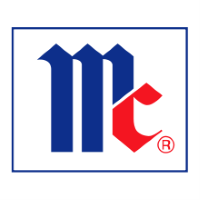
McCormick & Company Inc
NYSE:MKC


| US |

|
Johnson & Johnson
NYSE:JNJ
|
Pharmaceuticals
|
| US |

|
Berkshire Hathaway Inc
NYSE:BRK.A
|
Financial Services
|
| US |

|
Bank of America Corp
NYSE:BAC
|
Banking
|
| US |

|
Mastercard Inc
NYSE:MA
|
Technology
|
| US |

|
UnitedHealth Group Inc
NYSE:UNH
|
Health Care
|
| US |

|
Exxon Mobil Corp
NYSE:XOM
|
Energy
|
| US |

|
Pfizer Inc
NYSE:PFE
|
Pharmaceuticals
|
| US |

|
Palantir Technologies Inc
NYSE:PLTR
|
Technology
|
| US |

|
Nike Inc
NYSE:NKE
|
Textiles, Apparel & Luxury Goods
|
| US |

|
Visa Inc
NYSE:V
|
Technology
|
| CN |

|
Alibaba Group Holding Ltd
NYSE:BABA
|
Retail
|
| US |

|
3M Co
NYSE:MMM
|
Industrial Conglomerates
|
| US |

|
JPMorgan Chase & Co
NYSE:JPM
|
Banking
|
| US |

|
Coca-Cola Co
NYSE:KO
|
Beverages
|
| US |

|
Walmart Inc
NYSE:WMT
|
Retail
|
| US |

|
Verizon Communications Inc
NYSE:VZ
|
Telecommunication
|
Utilize notes to systematically review your investment decisions. By reflecting on past outcomes, you can discern effective strategies and identify those that underperformed. This continuous feedback loop enables you to adapt and refine your approach, optimizing for future success.
Each note serves as a learning point, offering insights into your decision-making processes. Over time, you'll accumulate a personalized database of knowledge, enhancing your ability to make informed decisions quickly and effectively.
With a comprehensive record of your investment history at your fingertips, you can compare current opportunities against past experiences. This not only bolsters your confidence but also ensures that each decision is grounded in a well-documented rationale.
Do you really want to delete this note?
This action cannot be undone.

| 52 Week Range |
64.61
84.76
|
| Price Target |
|
We'll email you a reminder when the closing price reaches USD.
Choose the stock you wish to monitor with a price alert.

|
Johnson & Johnson
NYSE:JNJ
|
US |

|
Berkshire Hathaway Inc
NYSE:BRK.A
|
US |

|
Bank of America Corp
NYSE:BAC
|
US |

|
Mastercard Inc
NYSE:MA
|
US |

|
UnitedHealth Group Inc
NYSE:UNH
|
US |

|
Exxon Mobil Corp
NYSE:XOM
|
US |

|
Pfizer Inc
NYSE:PFE
|
US |

|
Palantir Technologies Inc
NYSE:PLTR
|
US |

|
Nike Inc
NYSE:NKE
|
US |

|
Visa Inc
NYSE:V
|
US |

|
Alibaba Group Holding Ltd
NYSE:BABA
|
CN |

|
3M Co
NYSE:MMM
|
US |

|
JPMorgan Chase & Co
NYSE:JPM
|
US |

|
Coca-Cola Co
NYSE:KO
|
US |

|
Walmart Inc
NYSE:WMT
|
US |

|
Verizon Communications Inc
NYSE:VZ
|
US |
This alert will be permanently deleted.
 McCormick & Company Inc
McCormick & Company Inc
McCormick & Company Inc
McCormick & Company Inc., founded in 1889 by Willoughby M. McCormick, has steadily grown into a global leader in the spice, seasonings, and flavorings industry. What started as a small spice business peddling its wares from a horse-drawn wagon in Baltimore has transformed into a vast enterprise that flavors the kitchens of millions around the world. McCormick's success lies in its strategic acquisitions and relentless focus on quality, which have helped them build an extensive portfolio, including iconic brands like McCormick, Lawry's, and Old Bay. By continuously innovating and responding to consumer trends, such as the growing demand for organic and natural products, the company ensures its relevance and leadership.
Central to McCormick's operation is its robust supply chain, sourcing high-quality raw materials from farmers across the globe. This intricate supply network allows McCormick to maintain stringent quality control while producing a wide array of spice blends, herbs, and flavor solutions catering to both retail consumers and industrial clients. The retail segment includes household staples sold through supermarkets and online platforms, while the industrial side services restaurants and packaged food manufacturers with customized flavor solutions. Their business model thrives on creating value through brand strength and innovation, allowing McCormick & Company to maintain its position as a dominant force in the culinary world.

McCormick & Company Inc., founded in 1889 by Willoughby M. McCormick, has steadily grown into a global leader in the spice, seasonings, and flavorings industry. What started as a small spice business peddling its wares from a horse-drawn wagon in Baltimore has transformed into a vast enterprise that flavors the kitchens of millions around the world. McCormick's success lies in its strategic acquisitions and relentless focus on quality, which have helped them build an extensive portfolio, including iconic brands like McCormick, Lawry's, and Old Bay. By continuously innovating and responding to consumer trends, such as the growing demand for organic and natural products, the company ensures its relevance and leadership.
Central to McCormick's operation is its robust supply chain, sourcing high-quality raw materials from farmers across the globe. This intricate supply network allows McCormick to maintain stringent quality control while producing a wide array of spice blends, herbs, and flavor solutions catering to both retail consumers and industrial clients. The retail segment includes household staples sold through supermarkets and online platforms, while the industrial side services restaurants and packaged food manufacturers with customized flavor solutions. Their business model thrives on creating value through brand strength and innovation, allowing McCormick & Company to maintain its position as a dominant force in the culinary world.





























 You don't have any saved screeners yet
You don't have any saved screeners yet
